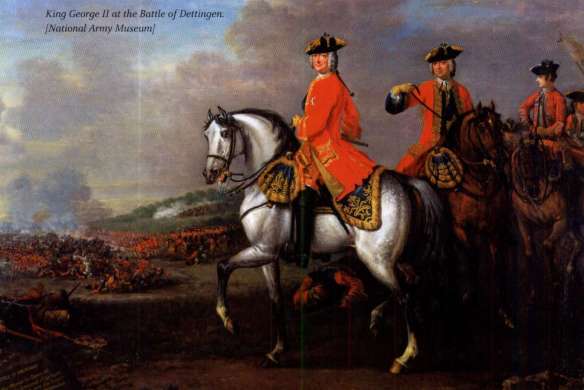George II at the Battle of Dettingen. George II, who was born in 1683, was king of Britain from 1727 to 1760 as a member of the Hanoverian line. He was brought up to a military life and military affairs were his major interest. He regulated his day with the precision of a drill sergeant, and he had a great knowledge of European military history. But this enthusiasm was matched by personal courage in battle, and on 27th June, 1743, during the war of the Austrian Succession, George commanded an army of English, Austrians and Hanoverians against the French at the battle of Dettingen – the last time a British monarch led his troops in person.
The decisive charge came when the king led his own foot regiments forward and shattered the French front line. George II died on 25th October, 1760, having seen British power increased in Europe, America, Africa and India.
The War of the Austrian Succession was a major global conflict, fought mainly in Europe, that involved most of the major European states with the exception of the Ottoman Empire, Portugal, and Poland. The war began as a result of Prussian designs on Austria’s province of Silesia. Prussia utilized the pretext that Maria Theresa of Austria could not inherit the Habsburg throne from her deceased father Charles VI. The war pitted Prussia, France, and Bavaria against Brit- ain, Spain, the Netherlands, and Russia, with Britain fighting against France and Spain over- seas in their adjoining colonial possessions in North America (King George’s War and the War of Jenkins’s Ear, respectively), with most of the other belligerents fighting in Europe. While the war began as a Prussian attempt to expand its territories in Germany, it rapidly turned into a major war. French and Spanish Bourbon at- tempts to engage the Austrian Habsburgs and British desires to prevent any one major power from dominating Europe led to their immediate involvement in the conflagration.
In 1740 Maria Theresa inherited the Habsburg throne upon the death of her father, complying with the stipulations adhered to by the Pragmatic Sanction of 1713, which the German states had agreed upon. Prussian king Frederick II decided to invade Silesia in December 16, 1740, thereby violating the Pragmatic Sanction and instigating war with Austria. Prussia’s well-trained forces were able to seize the province with ease as Austria prepared to meet the challenge during the following campaign season. By 1741 France and Bavaria had joined Prussia, and their forces plotted to take Vienna. However, Austrian counteroffensives were able to prevent the seizure of the Habsburg capital. Moreover, Maria Theresa was able to appeal to the Hungarian aristocracy and raise a levée en masse of troops to engage the foreign invasion of the Habsburg lands. Nonetheless, French forces were able to seize Prague and occupy Bohemia and install the elector of Bavaria as king of Bohemia by November 1741. He was subsequently elected Holy Roman emperor as Charles VII in January 1742. After unsuccessful attempts to remove the Prussians from Silesia, Austrians sued for peace on June 11, 1742, at Breslau, ending the First Silesian War.
In 1743 Bavarian and French forces suffered various setbacks in engaging Austrian forces and maintaining their positions along the Danube. Along with British forces, the Austrians were able to defeat French and Bavarian forces on June 27, 1743, at the Battle of Dettingen. The British, Dutch, and Austrian forces were now al- lied against the French and Bavarian forces, with Spain joining the latter coalition. Russia and Sweden were able to neutralize each other’s attempts to join the greater war, thereby minimizing their involvement. In 1744 after concluding a secret treaty with the French, the Prussians swept into Germany. This was at a time when Austria and its allies were distracted by French forces under Louis XV in northern Europe amassed against the Austrian Netherlands. While British, Austrian, and Dutch forces were able to successfully engage French forces along the Rhine in various engagements, the Prussians ran unopposed across much of southern Germany.
In 1745 the Quadruple Alliance was officially formed by Britain, Austria, the Netherlands, and Saxony through the Treaty of Warsaw. With the death of Holy Roman Emperor Charles VII, the Holy Roman Empire’s throne again became con- tested. Prussian forces were able to maintain their position in Silesia and southern Germany, with Austrian forces unable to oust them. Francis I of Lorraine, the husband of Maria Theresa, was elected Holy Roman emperor, a move opposed by the Prussians and the Bavarians. Despite Prussian successes against Austrian forces, Frederick recognized Francis I’s acquisition of the Habsburg throne in the Peace of Dresden on December 25, 1745, while it was recognized by the Austrians that Silesia was a Prussian province. This agreement ended the Second Silesian War.
In southern Europe the war was characterized by Spanish and Italian engagements, given Bourbon Spanish attempts to acquire territory in Italy, particularly Milan, with Italian states divided in terms of their loyalties. As Austrian forces ousted Spanish forces from northern Italy, they occupied formerly independent Italian states, most notably Genoa. In contrast, in northern Europe, British and Dutch forces engaged French forces in defense of the Austrian Netherlands as well as their own possessions. With a Swedish-Russian settlement made in 1743, Russian forces, allied with Austria, marched from Moscow to the Rhine in 1746. The overwhelmed French and Spanish forces were forced to come to terms or continue fighting against the enlarged coalition. The Peace of Aix-la-Chapelle, signed on October 18, 1748, formally ended the War of the Austrian Succession. In the end, Prussia was able to retain Silesia at the expense of Austria, which was the trigger of the whole conflict.
Bibliography Anderson, Matthew Smith. The War of the Austrian Succession, 1740–1748. New York: Longman, 1995. Browning, Reed. The War of the Austrian Succession. New York: St. Martin’s, 1993.
